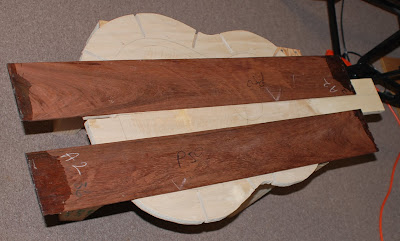Now it's time to make this thing more 3-dimensional by adding sides.
After the side is bent, it is clamped into a mold to hold its shape while making the measurements to determine where the ends are trimmed for the final fit.
The angled line (below) allows the side to fit into the slot that in the neck.
We also need a tail block to add reinforcement to the bottom of the guitar where the two sides meet. I had a piece of mahogany sitting around that will be good for this. Just needs to be sawn up...
After a lot of sawing, I got six tail blocks out of that hunk of wood.
Now everything is glued and clamped into place.
A lining has to be added to connect the sides to the top. Here, I'm using a traditional Spanish method of gluing individual triangle-shaped pieces (called tentallones, or dentallones) one at a time using hot hide glue. I'm beginning where the two cross bars meet the sides, and working around the perimeter.
I meant to take more photos along the way, but got too engrossed. The photo below shows all of the lining installed - the dentallones lining the top, and the lining that the back of the guitar will be glued to. A tricky bit here: since the back is radiused, the linings that the back will attach to have to be sloped to the same radius for a proper fit. That has already been done here, and our attention now shifts to preparing the back.
Next Post: The Back

























